#Biopython
Explore tagged Tumblr posts
Text
🐍 How to Learn Python for Bioinformatics? A Beginner’s Guide 🔬💻
Python is one of the most powerful and beginner-friendly programming languages for bioinformatics, making it essential for analyzing genomic data, automating workflows, and developing computational biology tools. If you're from a biotech or life sciences background and want to transition into bioinformatics, learning Python is the perfect first step!
Here’s a step-by-step guide to mastering Python for Bioinformatics from scratch. 🚀
📌 Step 1: Learn Python Basics
Before diving into bioinformatics-specific applications, build a strong foundation in Python programming. Start with:
✅ Basic Syntax – Variables, loops, conditionals ✅ Functions & Modules – Code reusability in Python ✅ Data Structures – Lists, dictionaries, tuples ✅ File Handling – Reading and writing biological data
📚 Best Free Courses to Start:
Python for Beginners – CS50 (Harvard) edX
Python Crash Course W3Schools
Automate the Boring Stuff with Python Udemy
📌 Step 2: Get Comfortable with Bioinformatics Libraries
Once you're comfortable with Python basics, start using bioinformatics-specific libraries to process biological data.
🔬 Key Libraries for Bioinformatics: ✅ Biopython – Sequence analysis, BLAST, FASTA/FASTQ file handling ✅ Pandas – Managing large biological datasets ✅ NumPy – Handling genetic sequence arrays ✅ Matplotlib & Seaborn – Data visualization for bioinformatics ✅ Scikit-learn – Machine learning for genomic analysis
🖥️ Try This Beginner Exercise: Download a FASTA file and use Biopython to parse and analyze a DNA sequence.
from Bio import SeqIO
# Read a FASTA file
for seq_record in SeqIO.parse("example.fasta", "fasta"): print(f"Sequence ID: {seq_record.id}")
print(f"Sequence: {seq_record.seq}")
print(f"Length: {len(seq_record.seq)}")
🔗 Best Resources for Learning BioPython:
Biopython Cookbook Official Docs
Intro to Biopython Course Datacamp
📌 Step 3: Work on Real Bioinformatics Projects
The best way to learn is through hands-on projects. Here are some beginner-friendly projects:
🧬 Project Ideas for Bioinformatics Beginners: ✅ DNA Sequence Analysis – Find GC content, transcription, and reverse complement. ✅ BLAST Automation – Write Python scripts to automate BLAST searches. ✅ Genome Data Visualization – Plot gene expression data using Matplotlib. ✅ Mutation Analysis – Identify and categorize SNPs in genomic sequences. ✅ Machine Learning in Bioinformatics – Train models for disease prediction.
📚 Practice with Real Datasets:
NCBI GenBank (ncbi.nlm.nih.gov)
ENSEMBL Genome Browser (ensembl.org)
Kaggle Bioinformatics Datasets (kaggle.com)
📌 Step 4: Join the Bioinformatics Community
Engaging with other bioinformatics learners and experts will keep you motivated and up to date.
🌎 Top Bioinformatics Communities: 💬 Biostars – biostars.org (Q&A forum for bioinformatics) 💻 Reddit – r/bioinformatics for discussions and resources 📢 Twitter/X – Follow researchers using #Bioinformatics #CompBio
📌 Step 5: Enroll in Online Courses & Certifications
Once you have some hands-on experience, take structured courses to solidify your knowledge.
📚 Best Courses for Python & Bioinformatics:
Bioinformatics Specialization – Coursera (UC San Diego)
Python for Genomic Data Science – Coursera (Johns Hopkins)
Bioinformatics with Python – BioPractify (biopractify.in)
🚀 Final Thoughts: Start Learning Today!
Python is revolutionizing bioinformatics, and learning it doesn’t require a programming background! Start with Python basics, explore bioinformatics libraries, work on real projects, and engage with the community. With consistent effort, you’ll be analyzing genomic data in no time!
📢 Are you learning Python for bioinformatics? Share your journey in the comments! 👇✨
#PythonForBioinformatics#Bioinformatics#ComputationalBiology#Genomics#MachineLearning#PythonProgramming#Biopython#GenomicData#BioinformaticsTools#BioTechCareers#CodingForBiologists#STEM#PythonBeginners#GenomeAnalysis#DataScience
1 note
·
View note
Text
Unraveling the Mysteries of COVID-19 Through Data Science
In the past few years, our world has been upended by the COVID-19 pandemic, affecting millions of lives and reshaping the future of public health, economies, and how we connect as a global community. Amidst these challenges, data science has emerged as a beacon of hope, offering innovative solutions and deep insights into the virus that has changed our way of life. The Power of Genomic…

View On WordPress
#Biopython#CollaborativeScience#Covid-19#DataScience#DataVisualization#Genomics#OpenScience#PandemicResponse#PublicHealth#VaccineDevelopment#ViralGenomics
0 notes
Text

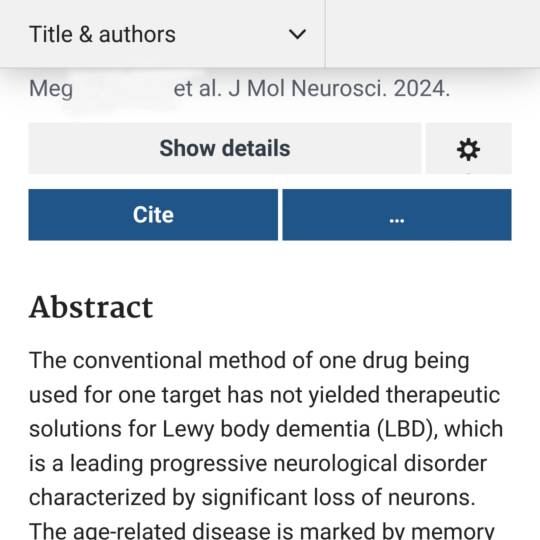

this week fortnight on megumi.fm ▸ the last leg
is that a pun referring to my aching ankle? yes. is resting at home for another week gonna ruin my mental health? yes. but am I exaggerating and throwing a tantrum for something that's probably not a big deal? also yes.
📋 Tasks
💻 Internship // progress tracker ↳ biopython model replication ✅ ↳ code for obtaining single fasta from overlapping sequences ✅ ↳ running HMMer and superfamily script✅ ↳ output analysis 🔁 ↳ literature review on transport proteins 🔁 ↳ transport protein family analysis 🔁 🎓 Uni ↳ our paper is finally out! there's a doi and everything now <3 it's not open access though :/// I might do some totally legal things to ensure more people can read it ↳ collected the hardcopy of my LOR ↳ collected my gradecard ↳ visited my advisor and updated her on stuff 🩺Radiomics Project ↳ radiomic features finalized✅ ↳ data cleanup 🔁
📅 Daily-s
🛌 consistent sleep [14/14] 💧 good water intake [14/14] 👟 exercise [/14] just basic stuff to maintain ankle mobility
Fun Stuff this week
💗i went to uni to watch one of my friends present something to the juniors! then I spent the afternoon chatting with my guide and later on went window shopping with my best friends (in retrospect i should not have done this because my ankle got infinitely worse the next day and now I'm stuck resting at home for an additional two weeks) 🎮playing undertale with @muakrrr 📺 ongoing: Marry my Husband, Cherry Magic Th, Perfect Propose, Doctor Slump, Flex X Cop 📺 binged: Blueming, Roommates of Poongduck 304 📹 Started watching Going Seventeen // so I've been listening to SVT for a while now and I did watch their Don't Lie II eps like two years ago but I never really checked anything else... however, considering that I'm stuck at home and that @zzzzzestforlife (who has impeccable taste) has mentioned it often on their posts, I decided to check out GoSe properly and. wow. I started with their mystery episodes [fav scenes under cut] and now I'm watching GoSe2020 in chronological order and !!!!!! The concepts, the storylines, the acting, the humour, the editing, even the subtitles are all so so good. I've been watching this show for two weeks now and I am now officially a cubic <3
📻 This week's soundtrack
Wk1: The Best of ATEEZ // I've been real obsessed since their 2024 world tour clips started showing up on social media; I was a casual enjoyer up to this point and then I went and checked them out and it's all so dystopian and immersive. My favourites would be Intro: Long Journey (which makes me feel like I'm in Pirates of the Caribbean), the Symphony version of Wonderland (for its musicality and Jungho hitting those notes), MATZ (that is insane in it's the visual storytelling in the MV) and Wake Up (whose performance choreo ended me) Wk2: The Best of BTS // in an attempt to revive a project I abandoned a year ago, I spent wayy too much time curating this playlist to get the most satisfying BTS transitions ever and I can confidently say that I'm nowhere close to my goal T-T but I kind of like the way it is now so I am simply going to give up
---
[Feb 12 to Feb 25 ; week 7+8/52 || this was not supposed to be one post but then... idk what happened... I feel very dull lately because of my ankle and just when I thought it was getting better it's become painful again... my friends and parents keep chastising me (and fairly so) for trying to move around even before I fully heal but patience has never been my strong suit. sitting still is really the biggest punishment for a hyperactive ADHD kid like me... i'm sure plenty others have it worse but... yeah... GoSe really carrying my mental health right now ]
my fav GoSe scenes















---
#52wktracker#studyblr#study blog#studyspo#stemblr#stem student#study goals#student life#college student#studying#stem studyblr#adhd studyblr#adhd student#study motivation#100 days of productivity#study inspo#study inspiration#gradblr#uniblr#studyinspo#sciblr#study aesthetic#study blr#study motivator#100 days of self discipline#100 days of studying#stem academia#bio student#100 dop#100dop
24 notes
·
View notes
Text
why TF IS IT CALLED BIOPYTHON. IF YOU DONT. IMPORT IT. AS. FUCKING. BIOPYTHON.
HOW WAS I SUPPOSED TO FUCKING KNOW TO GO "from Bio import Seq 🤓☝️" WHO NAMES A PYTHON MODULE SEQ ANYWAY
WHY TF DID I INSTALL A MODULE CALLED "BIOPYTHON" IN MY VIRTUAL ENVIRONMENT. AND THEN WHEN I ASK MY CODE TO IMPORT BIOPYTHON ITS ALL LIKE
"mOdULe nOt fOuNd- nO moDulE nAmEd 'biOpYtHon"
THERE IS TOO. I JUST IMPORTED IT. YOU SAID YOU IMPORTED IT. WHY CANT I JUST ASK YOU TO IMPORT BIOPYTHON WHEN I JUST INSTALLED IT. WHY DO I HAVE TO ASK YOU TO IMPORT "SEQ" FROM "BIO"??
WHY DOES IT HAVE TWO DIFFERENT NAMES. I SPENT TWO ENTIRE DAYS TRYING TO FIGURE THIS OUT.
#loserposting#crashing out#allbrows doesnt know how to code#well not just how to code but just#the way that IDEs work in general#or virtual environments#wtf is that shit#crash out#justified crashout#in my opinion#uhhhh coding?#coding#programming#python#research#girls in stem 🤪#stemblr#stem student#science
2 notes
·
View notes
Photo

Minicurso Pré-Evento | X-Meeting 2025 Biopython Quer aprender a usar Python para trabalhar com dados biológicos? Com Angelina Meiras-Ottoni, Natalia Coutoune e Juliana Félix 💻 Online 📅 20, 22, 27 e 29 de maio de 2025 (terças e quintas-feiras) 🕘 09h00 às 12h00 💸 R$25,00 ⚠ Curso exclusivo para inscritos no X-Meeting 2025! Garanta sua vaga e comece a programar para a ciência. #XMeeting2025 #MinicursoXMeeting #Biopython #Bioinformática #PythonParaBiologia #ProgramaçãoCientífica
0 notes
Text
How to get a gene sequence from entrez using biopython?
To retrieve a gene sequence from the NCBI Entrez database using Biopython, you can use the Entrez module from the Bio package. Below is a step-by-step guide on how to do this: Step 1: Install Biopython If you haven’t already installed Biopython, you can do so using pip: pip install biopython Enter fullscreen mode Exit fullscreen mode Step 2: Import Necessary Modules You need to import the…
0 notes
Text
Data Science in Biology
In recent years, the intersection of data science and biology has emerged as a transformative field, revolutionizing how researchers approach biological questions and challenges. This synergy has enabled biologists to harness the power of data to uncover insights that were previously inaccessible. In this blog post, we will explore the profound impact of data science in biology, highlighting its applications, tools, and future prospects.
Introduction to Data Science in Biology
Data science in biology involves the application of statistical techniques, machine learning algorithms, and computational methods to analyze biological data. This multidisciplinary approach enables researchers to make sense of vast datasets generated from genomics, proteomics, ecological studies, and more. By extracting meaningful patterns and relationships from complex biological data, data scientists and biologists collaborate to advance our understanding of living systems.
Applications of Data Science in Biology
Genomics and Personalized Medicine
One of the prominent areas where data science online training has made significant strides is in genomics. The Human Genome Project was a monumental undertaking that laid the foundation for genomic research, generating massive amounts of DNA sequence data. Today, data science techniques such as genome-wide association studies (GWAS) and deep learning algorithms are employed to unravel the genetic basis of diseases and develop personalized treatment strategies.
Ecology and Environmental Studies
In ecology, data science plays a crucial role in analyzing biodiversity patterns, species interactions, and ecosystem dynamics. Researchers use data science to model complex ecological systems, predict the impact of climate change on biodiversity, and inform conservation efforts. The integration of data science with field biology has led to more comprehensive insights into how ecosystems function and respond to environmental changes.
Bioinformatics and Computational Biology
Bioinformatics, a field at the intersection of biology and computer science, relies heavily on data scientist skills and techniques. It involves the development of algorithms and software tools to analyze biological data, ranging from DNA sequences to protein structures. Data science enables researchers to annotate genomes, predict protein functions, and simulate molecular interactions, accelerating drug discovery and biomedical research.
Tools and Techniques in Data Science for Biology
Python and R for Data Analysis
Python and R are two of the most popular programming languages in data science. They offer powerful libraries and frameworks such as pandas, numpy, scikit-learn (for machine learning), and BioPython (for bioinformatics). Biologists and data scientists leverage these tools to preprocess data, perform statistical analyses, visualize results, and build predictive models.
Machine Learning Algorithms
Machine learning plays a pivotal role in extracting insights from biological data. Supervised learning algorithms are used for tasks such as classification of diseases based on genomic data or prediction of protein structures. Unsupervised learning techniques help uncover hidden patterns in large datasets, facilitating discoveries in systems biology and drug development.
Data Visualization and Interpretation
Effective data visualization is essential for biologists to interpret and communicate their findings. Tools like matplotlib, seaborn, and ggplot2 enable researchers to create informative graphs, heatmaps, and interactive plots that reveal trends and relationships within biological datasets. Visual representations enhance understanding and facilitate data-driven decision-making in biological research.
What is Cross Entropy
youtube
Future Trends and Opportunities
The field of data science in biology is poised for continued growth and innovation. As technologies advance and datasets expand, new opportunities and challenges will emerge. Here are some future trends to watch:
Integration of Multi-Omics Data
With the rise of technologies like single-cell sequencing and spatial transcriptomics, biologists are generating multi-dimensional datasets that capture various biological molecules simultaneously. Data science certification will play a crucial role in integrating and analyzing these multi-omics data to gain a holistic understanding of biological systems.
AI and Deep Learning in Drug Discovery
Artificial intelligence (AI) and deep learning are transforming drug discovery pipelines by predicting drug-target interactions, designing novel compounds, and optimizing clinical trials. Data scientists and biologists collaborate to leverage these technologies, accelerating the development of new therapies for complex diseases.
Ethical Considerations and Data Privacy
As data collection becomes more extensive in biological research, addressing ethical concerns around data privacy, consent, and equity will be paramount. Data scientists and biologists must navigate these ethical landscapes responsibly to ensure the ethical use of data and uphold scientific integrity.
Data science has revolutionized biology by enabling researchers to extract actionable insights from complex datasets. From genomics to ecology, data science tools and techniques are reshaping how biological questions are answered and how discoveries are made. As the field continues to evolve, interdisciplinary collaboration between biologists and data scientists will be crucial for advancing our understanding of life and addressing global challenges in health, environment, and beyond.
Data science in biology offers exciting opportunities for those interested in pursuing careers at the intersection of life sciences and computational analysis. Whether through a formal data science course with job assistance or self-directed learning in data science online training, individuals can equip themselves with the skills needed to contribute to this dynamic and impactful field.
Whats is ADAM Optimiser?
youtube
#datasciencecourse#datasciencetraining#datascience#dataanalysis#datascientist#data science certification#Youtube
0 notes
Text
How is Python Beneficial to The Pharmaceutical Industry?
Streamlining Research and Development
Python's role in the pharmaceutical industry is increasingly significant, especially in research and development (R&D) sectors. The language's simplicity and flexibility enable researchers to streamline complex biological data analysis, enhancing the efficiency of drug discovery processes. Python’s extensive libraries, such as Biopython, provide tools that are crucial for bioinformatics, allowing scientists to process genetic data, simulate biological processes and predict molecular behavior. These capabilities make Python an indispensable tool in the fast-paced environment of pharmaceutical R&D.
Enhancing Data Analysis and Machine Learning
Advanced-Data Handling
In the pharmaceutical industry, managing vast amounts of data efficiently is crucial. Python facilitates this through its powerful data-handling capabilities. Pharmaceuticals Python tools like Pandas and NumPy help manage and analyze large datasets, which are common in clinical trials and drug testing phases. These tools enable researchers to perform complex statistical analyses and data visualization, crucial for interpreting clinical data results and making data-driven decisions.
Leveraging Machine Learning
Machine learning is transforming how pharmaceutical companies approach drug design and patient treatment strategies. Python stands out with its rich ecosystem of machine learning libraries, such as TensorFlow and Scikit-learn. These pharmaceuticals Python tools allow companies to develop predictive models that can forecast drug interactions, treatment outcomes and patient responses. By incorporating machine learning techniques, pharmaceutical companies can significantly reduce the time and cost associated with bringing a new drug to market.
In conclusion, Python's versatility and its array of specialized libraries support critical operations across various phases of the pharmaceutical industry. From enhancing drug discovery and development to improving the accuracy of clinical trials and patient care strategies, Python's role as a powerful tool in this sector continues to grow, marking it as a cornerstone in the technological advancement of pharmaceuticals.
Read a similar article about Google spreadsheet automation here at this page.
#pharmaceuticals python tools#beginner projects python#python for data science#python training for enterprise
0 notes
Text
Delving into Python’s Expansive Ecosystem: Transformative Applications and Impact
Python stands as more than merely a programming language; it's a transformative force across various sectors. Its blend of simplicity and powerful functionalities has propelled it into a multitude of sectors, revolutionizing traditional methodologies with innovative solutions. From web development and data science to artificial intelligence (AI), financial analytics, scientific computation, and beyond, Python’s scope is vast. Embarking on a Python Course in Hyderabad can significantly sharpen your expertise, unlocking the door to ample opportunities Python presents in numerous fields. This blog delves into Python's versatile applications and its significant influence on the industries it pervades.
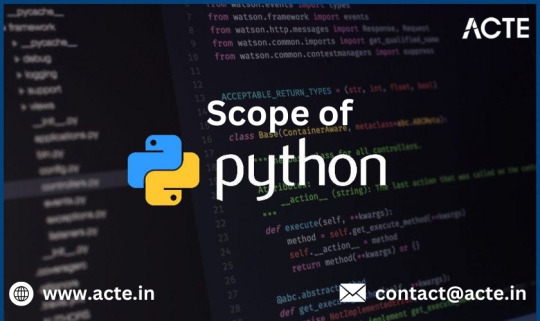
Diverse Applications Across Multiple Fields
Web Development
Python streamlines the web development process via its frameworks such as Django and Flask, facilitating the creation of secure, scalable websites. It’s the powerhouse behind Instagram’s backend and empowers startups to swiftly roll out their platforms, proving indispensable for web developers.
Data Science and Analytics
Acting as the data science community's common tongue, Python, with its libraries like pandas, NumPy, and Matplotlib, simplifies complex data analyses, enabling efficient insight extraction and trend forecasting. This turns data into a pivotal asset in strategic business decisions.
Artificial Intelligence and Machine Learning
The simplicity and extensive library support in Python render it perfect for AI and ML endeavors. Tools like TensorFlow, Keras, and Scikit-learn have made sophisticated machine learning technologies accessible to all, facilitating the creation of systems and models capable of tasks once thought exclusive to human intelligence.
Finance
Python finds extensive use in finance for both analytical and algorithmic operations, including financial modeling and trading strategy development. Libraries such as QuantLib and pyfolio support asset analysis, risk management, and portfolio optimization, positioning Python as a core tool in finance and trading.
Scientific Computing
Invaluable in scientific research, Python aids complex calculations, simulations, and data analysis across various scientific disciplines. It accelerates prototyping and problem-scaling in research areas, assisted by tools like SciPy, NumPy, and BioPython.
Education
With its clear syntax, Python emerges as a prime tool in education, often being the first programming language taught. It bridges the gap between theoretical computational concepts and their practical application, promoting problem-solving and computational thinking skills.
Game Development
Python extends its reach to game development, where libraries like Pygame enable swift game creation with minimal code, appealing particularly to indie developers.
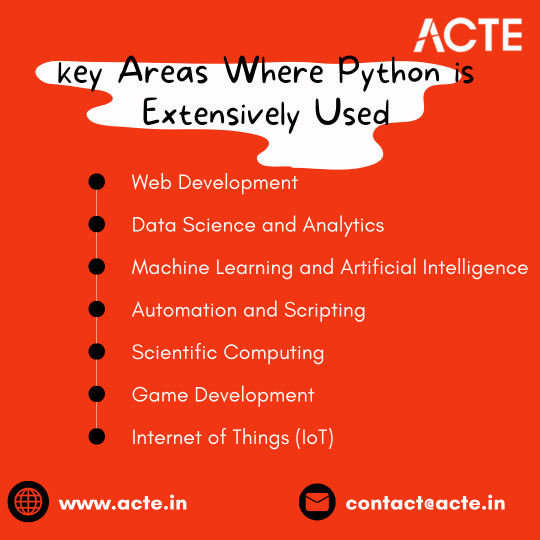
Influential Impact of Python
Python's extensive applications are matched by its profound impact and the vibrant community it has nurtured. Hosting millions of developers with a growing pool of resources, libraries, and frameworks, Python makes a significant mark in the tech sphere.
Community and Collaboration: Python's robust community is among its greatest assets, celebrated for its inclusivity and diversity. A wealth of resources, coupled with international meetups and conferences, cultivates a collaborative atmosphere that drives Python’s widespread use and innovation across fields. This Python Online course is designed to help both novices and seasoned developers contribute to groundbreaking projects and advance professionally.
Innovation and Accessibility: By lowering the barrier to entry in programming, Python fosters greater diversity in software development. Its approachability and versatility invite wider participation in development activities, spurring innovation and accelerating technological progress.
Role in Education: Introducing more students to programming through Python prepares the future workforce for a landscape where coding might be as crucial as conventional literacy skills.
Conclusion
The simplicity and potency of Python account for its widespread acceptance and significant role in reshaping the technological domain. As industries and technology evolve, Python’s influence is poised to grow, heralding a future rich in innovation and cross-industry transformation. Python is not just for seasoned developers; it offers a world brimming with possibilities for those eager to explore and make their mark.
0 notes
Text
Python's Critical Role in Bioinformatics and Technologies Improves Your Educational Journey
Python has emerged as a powerhouse in the fields of bioinformatics and computational biology, offering a versatile and accessible platform for a wide range of tasks, from data analysis to biological modeling. In this blog post, we'll explore the key ways in which Python is transforming the world of biology and how ACTE Technologies can help you embark on a successful educational journey in Python.
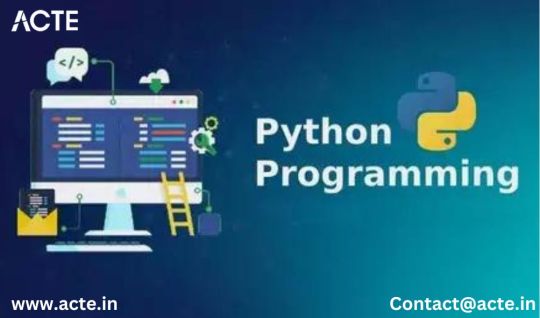
1. Bioinformatics:
Python's popularity in bioinformatics is driven by libraries like Biopython, which empower researchers to process and analyze biological data effortlessly. This includes tasks such as sequence manipulation, sequence alignments, and parsing common genomic file formats.
2. Data Analysis:
Python's data analysis libraries, including NumPy, Pandas, and Matplotlib, are invaluable tools for biologists. These libraries enable the analysis and visualization of large datasets, aiding in the extraction of meaningful insights from biological experiments and studies.
3. Machine learning and AI:
Python boasts a rich ecosystem of machine learning and artificial intelligence libraries like TensorFlow, PyTorch, and scikit-learn. These libraries play a crucial role in tasks such as image analysis, drug discovery, and genomics research.
4. Web Development:
Python is instrumental in creating web interfaces for biological databases and analysis pipelines. Frameworks like Django and Flask are commonly used to build bioinformatics tools and applications.
5. Biological Simulation:
Python, through libraries like BioSimPy, enables the simulation of complex biological processes and models. This aids researchers in gaining a deeper understanding of various biological phenomena.
6. Visualization:
Python's visualization libraries, such as Matplotlib, Seaborn, and Plotly, empower biologists to create informative and visually appealing charts and plots for presentations and publications.
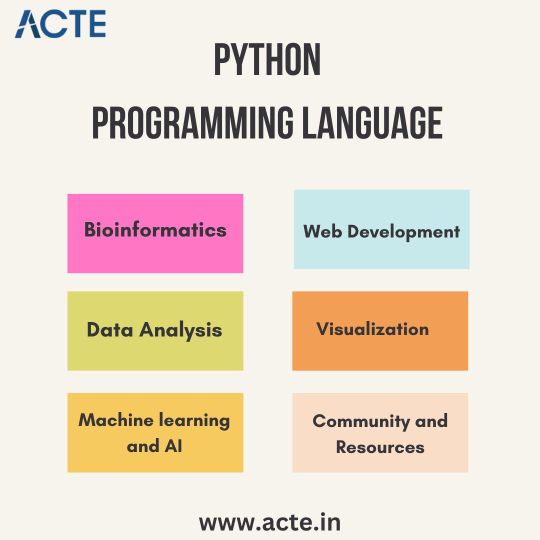
7. Data Handling:
Python's extensive libraries simplify the handling and manipulation of diverse biological data types, including DNA sequences, protein structures, and experimental results.
8. Collaboration:
Python's simplicity and readability make it an ideal language for collaborative research in biology. Its code is easily shareable and understandable among researchers.
9. Community and Resources:
Python boasts a supportive community of bioinformaticians and biologists who actively contribute to open-source projects, share code, and offer assistance through forums and mailing lists.
In this case, Python provides a unique greeting once you inquire about the user's name.
Free and Open Source:
Python is completely free to use. You can download it from the official website (python.org) and start writing code without paying anything. Plus, it's open source, which means a global community of developers continually improves and maintains it.
Huge community and resources:
Because Python is so popular, there's a massive community of Python enthusiasts. You can find tutorials, courses, forums, and libraries to help you learn and solve problems.
Cross-Platform:
Python works on different operating systems, like Windows, macOS, and Linux. You don't have to worry about compatibility issues when you switch between computers.
In a nutshell, Python is a user-friendly, versatile, and powerful programming language. It's perfect for beginners because of its readability and for experts because of its extensive libraries and capabilities. Whether you want to build websites, analyze data, or create AI, Python is a fantastic choice to start your coding journey. So, why not give it a try? Say "Hello, World!" to Python today!
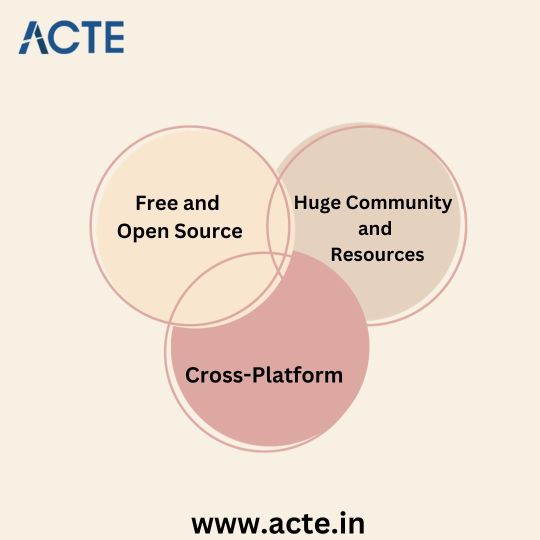
Your Educational Journey For Python Training
ACTE Technologies offers a comprehensive Python program that includes practical exercises, assignments, and real-world projects, ensuring you gain practical experience and a deep understanding of Python. Learn from seasoned Python professionals who provide industry-relevant guidance, setting you up for success in the field. ACTE Technologies assists in job placement, leveraging their connections with employers to help you secure Python-related positions. Choose between offline and online Python classes to accommodate your schedule and learning preferences.
Python is an indispensable tool in biology, driving advancements in research and analysis. ACTE Technologies is your partner in mastering Python, offering comprehensive training and support to help you unlock the doors to a rewarding career in the fields of bioinformatics and computational biology.
1 note
·
View note
Text

It's really basic but I have to hand it to Matplotlib. She does so much for me. Honorable mention to the Biopython PDB module because it works surprisingly well for how much of a wild wild west that area is
I hadn't looked at cuTile yet but that looks really cool, I love efficient use of GPUs
I just barely made it to the terminal of my connecting flight, like barely made it because they were halfway through boarding, but before they could call my group they announced there’s a problem with the plane and we’re delayed 2 hours. Fuck my stupid baka life
53 notes
·
View notes
Text
Free online courses for bioinformatics beginners
🔬 Free Online Courses for Bioinformatics Beginners 🚀
Are you interested in bioinformatics but don’t know where to start? Whether you're from a biotechnology, biology, or computer science background, learning bioinformatics can open doors to exciting opportunities in genomics, drug discovery, and data science. And the best part? You can start for free!
Here’s a list of the best free online bioinformatics courses to kickstart your journey.
📌 1. Introduction to Bioinformatics – Coursera (University of Toronto)
📍 Platform: Coursera 🖥️ What You’ll Learn:
Basic biological data analysis
Algorithms used in genomics
Hands-on exercises with biological datasets
🎓 Why Take It? Ideal for beginners with a biology background looking to explore computational approaches.
📌 2. Bioinformatics for Beginners – Udemy (Free Course)
📍 Platform: Udemy 🖥️ What You’ll Learn:
Introduction to sequence analysis
Using BLAST for genomic comparisons
Basics of Python for bioinformatics
🎓 Why Take It? Short, beginner-friendly course with practical applications.
📌 3. EMBL-EBI Bioinformatics Training
📍 Platform: EMBL-EBI 🖥️ What You’ll Learn:
Genomic data handling
Transcriptomics and proteomics
Data visualization tools
🎓 Why Take It? High-quality training from one of the most reputable bioinformatics institutes in Europe.
📌 4. Introduction to Computational Biology – MIT OpenCourseWare
📍 Platform: MIT OCW 🖥️ What You’ll Learn:
Algorithms for DNA sequencing
Structural bioinformatics
Systems biology
🎓 Why Take It? A solid foundation for students interested in research-level computational biology.
📌 5. Bioinformatics Specialization – Coursera (UC San Diego)
📍 Platform: Coursera 🖥️ What You’ll Learn:
How bioinformatics algorithms work
Hands-on exercises in Python and Biopython
Real-world applications in genomics
🎓 Why Take It? A deep dive into computational tools, ideal for those wanting an in-depth understanding.
📌 6. Genomic Data Science – Harvard Online (edX) 🖥️ What You’ll Learn:
RNA sequencing and genome assembly
Data handling using R
Machine learning applications in genomics
🎓 Why Take It? Best for those interested in AI & big data applications in genomics.
📌 7. Bioinformatics Courses on BioPractify (100% Free)
📍 Platform: BioPractify 🖥️ What You’ll Learn:
Hands-on experience with real datasets
Python & R for bioinformatics
Molecular docking and drug discovery techniques
🎓 Why Take It? Learn from domain experts with real-world projects to enhance your skills.
🚀 Final Thoughts: Start Learning Today!
Bioinformatics is a game-changer in modern research and healthcare. Whether you're a biology student looking to upskill or a tech enthusiast diving into genomics, these free courses will give you a strong start.
📢 Which course are you excited to take? Let me know in the comments! 👇💬
#Bioinformatics#FreeCourses#Genomics#BiotechCareers#DataScience#ComputationalBiology#BioinformaticsTraining#MachineLearning#GenomeSequencing#BioinformaticsForBeginners#STEMEducation#OpenScience#LearningResources#PythonForBiologists#MolecularBiology
9 notes
·
View notes
Photo

LAST CALL FOR REGISTRATION PYTHON AND BIOPYTHON BIOINFORMATICS WORKSHOP FOR BIOLOGISTS | TECHNICAL CERTIFICATE WORKSHOP | 3 DAYS ⏳ 7-9 May ✨✨ Fee from ₹ 2000 ➡️ Online session from 8:30 PM - 10 PM IST (GMT +5:30) 🖥️🖥️ Hands-on practical sessions to give user a unique learning experience Details & Registration 👉👉 https://www.bdglifesciences.com/workshop-online?workshopId=470 Check out https://www.bdglifesciences.com/ for other programs like Courses, Workshops & Research Projects #envisionwithbdg #itsdifferentbybiodiscovery #bdglifesciences #bioinformatics #biotechnology #bioinformaticscompany #10yearsofexcellence #biodiscoverygroup #onlineteaching #onlinelearning #pythonprogramming #pythonforbiology #biopython https://www.instagram.com/p/COcZkMpjU3_/?igshid=1jqc78nyq2brs
#envisionwithbdg#itsdifferentbybiodiscovery#bdglifesciences#bioinformatics#biotechnology#bioinformaticscompany#10yearsofexcellence#biodiscoverygroup#onlineteaching#onlinelearning#pythonprogramming#pythonforbiology#biopython
0 notes
Note
wait i just read you had bionformatics, how cool!!! would you mind sharing what you studied/are studying? :)
I do cancer research, it's kind of impossible to do anything without bioinformatics these days though I only do basic things myself and collaborate with actual bioinformaticians more often :) my undergrad was biochem so that included a bit of bioinformatics
1 note
·
View note
Text
more updates as of 17th Feb, 2024
🔄 I did some modifications and now im running the script twice in parallel. the script now takes 5 seconds per file rather than the previous 10s, aka literally half the time. this saves me about 12hours. currently it is done processing 14120/23391 files. ✅ replicate the fasta-seq code of same functionality using the biopython module ^^ my internship teammate did this and turns out his version is actually a bit slower than mine, so we've just decided to keep my original modules code a script that extracts uniprot accession number from AF file -> goes to that entry in uniprot -> obtains the entire protein sequence directly from there this won't work because a turns out that a couple of the reference uniprot IDs in the files are outdated... brrrr....
to dos // updated 14th Feb, 2024
primary tasks
✅ compile fasta seq into a single file ✅ look up structural superimposition tools for protein annotation
48 notes
·
View notes
Text
9/100
9/01/23
Hey everyone; today was great and hard at the same time, I didn't really have much energy after classes and had to make a lot of hard decisions, but all in all I'm proud of myself and the fact that I managed to stay positive today.
With my ADHD it's especially hard to do things subsequently after they get assigned to me, I procrastinate a lot and that may be then the source of my anxiety. But today I didn't do that at all. I was executing all day. It was awesome.
Productivity diary
Physiology notes for the upcoming test
French Duolingo
French textbook chapter 0
Microbiology slides from the previous class
Skimmed through the BioPython manual; tried out a few things
A sort of business meeting to discuss a sort of promotion in my student organisation - a lot of mental preparation
My progress is enough for today
Logging out,
Liv
#studyblr#vet med#100 days of productivity#study motivation#coding#french#stem#studying#woman in stem#motivation#100 days of code#veterinary medicine#vetblr#veterinary medicine student#veterinary#study diary#daily uni#daily diary
10 notes
·
View notes